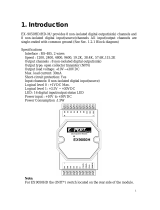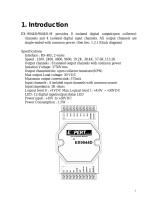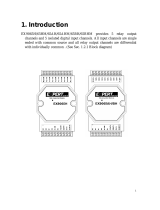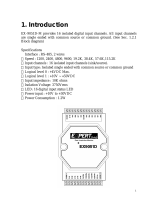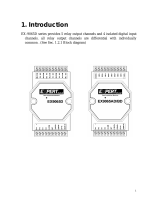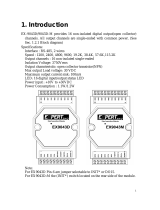Page is loading ...

I-7080, I-7080B
User Manual
Create New Ideas
Create New Applications
Your Powerful Tools
I-7000 New Features
1. Self Tuner Inside
2. Multiple Baud Rate
3. Multiple Data Format
4. Dual WatchDog Inside
5. True Distributed Control
6. High Speed & High
Density I/O
Warranty
All products manufactured by ICP DAS are warranted
against defective materials for a period of one year from the date
of delivery to the original purchaser.
Warning
ICP DAS assume no liability for damages consequent to the
use of this product. ICP DAS reserves the right to change this
manual at any time without notice. The information furnished by
ICP DAS is believed to be accurate and reliable. However, no
responsibility is assumed by ICP DAS for its use, nor for any
infringements of patents or other rights of third parties resulting
from its use.
Copyright
Copyright 1998 by ICP DAS. All rights are reserved.
Trademark
The names used for identification only maybe registered
trademarks of their respective companies.
I-7080, I-7080D, I-7080B, I7080BD User Manual (V 2.0) ------------------ 1

Table of Contents
1. INTRODUCTION.........................................................................................................................4
1.1 7080/7080D
& 4080/4080D......................................................................................................5
1.2
PIN ASSIGNMENT..........................................................................................................................7
1.3 S
PECIFICATIONS..........................................................................................................................8
1.4
BLOCK DIAGRAM ........................................................................................................................9
1.5
APPLICATION WIRING ...............................................................................................................10
1.6
QUICK START.............................................................................................................................12
1.7
DEFAULT SETTING .....................................................................................................................14
1.8
APPLICATION NOTES..................................................................................................................14
1.9
TABLES ......................................................................................................................................21
2. COMMAND SET........................................................................................................................22
2.1
%AANNTTCCFF......................................................................................................................25
2.2 #AAN.......................................................................................................................................26
2.3 ~** ...........................................................................................................................................27
2.4 ~AA0........................................................................................................................................28
2.5 ~AA1........................................................................................................................................29
2.6 ~AA2........................................................................................................................................30
2.7 ~AA3ETT ................................................................................................................................31
2.8 ~AAAS.....................................................................................................................................32
2.9 ~AAO(
NAME)...........................................................................................................................33
2.10 $AA0H................................................................................................................................34
2.11 $AA0H(
DATA).....................................................................................................................35
2.12 $AA0L.................................................................................................................................36
2.13 $AA0L(
DATA).....................................................................................................................37
2.14 $AA1H................................................................................................................................38
2.15 $AA1H(
DATA).....................................................................................................................39
2.16 $AA1L.................................................................................................................................40
2.17 $AA1L(
DATA).....................................................................................................................41
2.18
$AA2....................................................................................................................................42
2.19 $AA3N................................................................................................................................43
2.20 $AA3N(
DATA).....................................................................................................................44
2.21 $AA4...................................................................................................................................45
2.22 $AA4S.................................................................................................................................46
2.23 $AA5N................................................................................................................................47
2.24 $AA5NS..............................................................................................................................48
2.25 $AA6N................................................................................................................................49
I-7080, I-7080D, I-7080B, I7080BD User Manual (V 2.0) ------------------ 2

2.26 $AA7N................................................................................................................................50
2.27 $AA8...................................................................................................................................51
2.28 $AA8V................................................................................................................................52
2.29 $AA9(
DATA)........................................................................................................................53
2.30 $AAA..................................................................................................................................54
2.31 $AAAG...............................................................................................................................55
2.32 $AAB ..................................................................................................................................56
2.33 $AABS................................................................................................................................57
2.34 $AAF...................................................................................................................................58
2.35 $AAI....................................................................................................................................59
2.36 $AAM..................................................................................................................................60
2.37 @AADI...............................................................................................................................61
2.38 @AADO0D.........................................................................................................................62
2.39 @AAEAN...........................................................................................................................63
2.40 @AAEAT............................................................................................................................64
2.41 @AACA..............................................................................................................................65
2.42 @AADA..............................................................................................................................66
2.43 @AADAN...........................................................................................................................67
2.44 @AAGN..............................................................................................................................68
2.45 @AAPN(
DATA)...................................................................................................................69
2.46 @AAPA(
DATA)...................................................................................................................70
2.47 @AAPA(
DATA)...................................................................................................................71
2.48 @AASA(
DATA)...................................................................................................................72
2.49 @AASA(
DATA)...................................................................................................................73
2.50 @AARP...............................................................................................................................74
2.51 @AARP...............................................................................................................................75
2.52 @AARA..............................................................................................................................76
2.53 @AARP...............................................................................................................................77
3. OPERATIONS PRINCIPLE & APPLICATION NOTES......................................................78
3.1 INIT*_
PIN OPERATION PRINCIPLE............................................................................................78
3.2
D/O OPERATION PRINCIPLE.......................................................................................................79
3.3 New Features of 7080B …………………………………………………….80
I-7080, I-7080D, I-7080B, I7080BD User Manual (V 2.0) ------------------ 3

1. Introduction
I-7000 is a family of network data acquisition and control
modules. They provide A/D, D/A, DI/O, Timer/Counter and other
functions. These modules can be remote controlled by a set of
commands. The common features of I-7080 and I-7080D are given
as following:
z 2 independent 32-bit counter, counter 0 & counter 1
z input signal can be isolated or non-isolated
z programmable digital filter for isolated and non-isolated input
z external gate control for isolated and non-isolated input
z programmable threshold value for non-isolated input.
z programmable alarm output
z input frequency measurement up to 100K Hz
The I-7080D is the I-7080 with a 5-digit LED display. The
counter value and input signal frequency can be shown in LED
directly without PC control. The I-7080B will save counter value to
EEPROM when the power is off. Refer to Sec. 3.3 for details.
More Information
Refer to “I-7000 Bus Converter User Manual” chapter 1
for more information as following:
1.1 I-7000 Overview
1.2
I-7000 RELATED DOCUMENTATION
1.3
I-7000 COMMON FEATURES
1.4
I-7000 SYSTEM NETWORK
CONFIGURATION
1.5 I-7000 Dimension
I-7080, I-7080D, I-7080B, I7080BD User Manual (V 2.0) ------------------ 4

1.1 7080/7080D & 4080/4080D
Comparison between I-7080 & I-7080D
I-7080 I-7080D
5-digit LED No Yes
Response to LED
command
No Yes
Module name programmable programmable
Counter preset value Yes(programmable) Yes(programmable)
Alarm on counter 0 only Yes(programmable) Yes(programmable)
Alarm on counter 0&1 Yes(programmable) Yes(programmable)
Channel 0 & channel 1 are
both non-isolated
(input mode 0, $AAB0)
Yes Yes
Channel 0 & channel 1 are
both isolated
(input mode 1, $AAB1)
Yes Yes
Channel 0 is non-isolated
& channel 1 is isolated
(input mode 2, $AAB2)
Yes Yes
Channel 0 is isolated &
channel 1 is non-isolated
(input mode 3, $AAB3)
Yes Yes
Input frequency 100K max. 100K max.
Default setting 4080 compatible 4080D compatible
default setting of I-7080:
z High alarm on counter 0 & 1
z Counter preset value: 0
z Module name: 7080
default setting of I-7080D:
z High/High-High alarm on counter 0
z Counter preset value: 0
z Module name: 7080D
I-7080, I-7080D, I-7080B, I7080BD User Manual (V 2.0) ------------------ 5

Comparison between 4080 & 4080D
4080 4080D
5-digit LED No Yes
Response to LED command No Yes
Module name 4080 4080D
Counter preset value Yes No
Alarm on counter 0 only No Yes
Alarm on counter 0&1 Yes No
Channel 0 & channel 1 are
both non-isolated
(input mode 0, $AAB0)
Yes Yes
Channel 0 & channel 1 are
both isolated
(input mode 1, $AAB1)
Yes Yes
Channel 0 is non-isolated &
channel 0 is isolated
(input mode 2, $AAB2)
No No
Channel 0 is isolated &
channel 1 is non-isolated
(input mode 3, $AAB3)
No No
Input frequency 50K max. 50K max.
I-7080, I-7080D, I-7080B, I7080BD User Manual (V 2.0) ------------------ 6

1.2 Pin Assignment
Isolated Input
Non-isolated Input
I-7080, I-7080D, I-7080B, I7080BD User Manual (V 2.0) ------------------ 7

1.3 Specifications
i-7080: Counter/Frequency Module
i-7080D: i-7080 with LED Display
i-7080B: Refer to Sec. 3.3 for details.
i-7080BD: Refer to Sec. 3.3 for details.
Counter Input
z Channels: Two independents 32 bit counters, counter 0&1
z Input signal: Isolated or non-isolated programmable
z Isolation input levels:
Logic level 0: +1V max.
Logic level 1: +3.5V to +30V
z Isolation voltage: 3750 Vrms
z non-isolation input threshold level: programmable
Logic level 0: 0 to +5V (default = 0.8V)
Logic level 1: 0 to +5V (default = 2.4V)
z Maximum count: 32 bit (4,294,967,295)
z Programmable digital noise filter: 2 us to 65 ms
z Alarming: alarm on counter 0 or counter 0&1, programmable
z Counter preset value: programmable
Display
z LED Indicator: 5-digit readout, channel 0 or channel 1
Frequency Measurement
z Input frequency: 1Hz to 100K Hz max.
z Programmable built-in gate time: 1.0/0.1sec
Digital Output
z 2 channels, open-collector to 30V, 30mA max. load
z Power dissipation: 300mW
Power
z Power requirements: +10V to 30V(non-regulated)
z Power consumption : 2W for I-7080, 2.2W for I-7080D
I-7080, I-7080D, I-7080B, I7080BD User Manual (V 2.0) ------------------ 8

1.4 Block Diagram
Embedded
Controller
Programmable Digital Filter
EEPROM
RS-485
DC
DC
5V
0V
D/O
O.C.
5-digit LED (I-7080D)
5V
Counter_0
Counter_1
5V
Gate0+
Isolated/Non-isolated input selection
Isolated/Non-isolated gate selection
Gate0-
5V
Gate1+
Gate1-
In0+
In0-
In1+
In1-
5V
Isolated input
Gate0(TTL)
Gate1(TTL)
In0(TTL)
In1(TTL)
Programmable threshold
voltage
Save to
EEPROM
Voltage
Detect
For 7080B/7080BD only
Non-isolated in
p
ut
Alarm
Output
D+
D-
V+
V-
I-7080, I-7080D, I-7080B, I7080BD User Manual (V 2.0) ------------------ 9

1.5 Application Wiring
1.5.1 Output Drive SSR or Other Load
I-7018 & I-7018D
Ex
t.
GN
D
Ex
t.
24
V
R
S
-4
85
D
ata
-
RS
-
485 Data
-
7
6
5
4
3
8
2
1
9
1
0
GN
D
+
VS
Data
+
Data
-
In0
D.Gn
d
Gate0
Init*
12
11
Gate
1-
Gate1
+
14
15
1
6
17
18
13
1
9
20
In1-
Do1/Hi
D
o0/
L
o
In0
+
Gate1
In1
In1
+
Gate0
-
Gate0+
In0
-
SSR AC
+VS
R2
External Load
External Powe
r
1N4001
R1
Note:
z If the external load is resistive load, the 1N4001 can be omitted.
(transistor, lamp, resistor, …)
z If the external load is inductive load, the 1N4001 can’t be omitted.
(relay, coil, …)
I-7080, I-7080D, I-7080B, I7080BD User Manual (V 2.0) ------------------ 10

1.5.2 Frequency Input
Use $AABS command to select isolated/non-isolated input.
I-7018 & I-7018D
20
Gate1
-
Gate
1+
In1
-
In1
+
Gate0
-
Gate0+
In
0
-
In0
+
Do0/Lo
Do1/Hi
11
12
14
16
17
18
Frequency 0
(isolated)
1
9
15
Frequency 1
(isolated)
13
+
VS
Data
+
Data
-
Init*
Gate1
In1
D.Gn
d
Gate0
In0
GND
10
9
8
Ext. GND
Ext. 24V
RS
-
485 Data
-
RS
-
485 Data
-
7
6
5
4
3
2
Frequency-0
(non-iolated)
Frequency-1
(non-iolated)
1
1.5.3 Counter Input
I-7018 & I-7018D
2
0
Gate1
-
Gate1
+
In1
-
In1
+
Gate0
-
Gate0+
In0
-
In0
+
Do0/Lo
Do1/Hi
12
11
14
15
16
17
18
1
3
Counter-0
& Gate-0
(isolated)
Counter-1
& Gate-1
(isolated)
19
+
VS
D
ata
+
Data
-
Init*
Gate1
In1
D.Gn
d
Gate0
In0
GND
10
9
8
Ext. GND
Ext. 24V
RS
-
485 Data
-
RS
-
485 Data
-
7
6
5
4
3
2
Counter-0 &
Gate-0
(non-iolated)
Counter-1 &
Gate-1
(non-iolated)
1
I-7080, I-7080D, I-7080B, I7080BD User Manual (V 2.0) ------------------ 11

1.6 Quick Start
Refer to “I-7000 Bus Converter User Manual” chapter-5 for
the following functions:
z module status unknown(Sec. 5.1), change address(Sec. 5.2)
z change baud rate(Sec. 5.3), checksum enable/disable(Sec. 5.4)
z Wire connection(Sec 2.4)
z Test program TEST.EXE(Refer to “NAP7000S User
Manual” for details.
1.6.1 Frequency Input Measurememt
1. Refer to Sec. 1.5.2 for wire connection. Power on and run test.exe
2. press 2
3. press $012[Enter] Æ Receive=!01500600
4. press 2
5. press %0101510600[Enter]Æ Receive=>!01
6. press 2
7. press $01B0[Enter] Æ Receive=!01
8. press 2
9. press #010[Enter] Æ Receive=>????????
10. press 2
11. press #011[Enter] Æ Receive=>????????
z step 3: the status of I-7080 is COUNTER mode
z step 5: change to frequency mode
z step 7: select non-isolated input
z step 9: frequency measurement of channel-0
z step 11: frequency measurement of channel-1
Note: the command $01B1(step 7) can be used to select the iso-
lated input.(the command $01B2 and $01B3 are used for
the other selections)
I-7080, I-7080D, I-7080B, I7080BD User Manual (V 2.0) ------------------ 12

1.6.2 Counter input Measurement
1. Refer to Sec. 1.5.2 for wire connection. Power on and run test.exe
2. press 2
3. press $012[Enter] Æ Receive=!01500600
4. press 2
5. press $01B0[Enter] Æ Receive=!01
6. press 2
7. press #010[Enter] Æ Receive=>????????
8. press 2
9. press #011[Enter] Æ Receive=>????????
z step 3: the status of I-7080 is COUNTER mode
z step 5: select non-isolated input
z step 7: counter measurement of channel-0
z step 9: counter measurement of channel-1
Note: the command $01B1(step 7) can be used to select the iso-
lated input.(the command $01B2 and $01B3 are used for
the other selections)
I-7080, I-7080D, I-7080B, I7080BD User Manual (V 2.0) ------------------ 13

1.7 Default Setting
The default setting is given as following:
z address=01
z baud rate=9600
z checksum disable
z data=1 start+8 data+1 stop(no parity)
z type=50 Æ counter input
z alarm=hi alarm on counter 0 & counter 1 (I-7080)
hi/hi-hi alarm on counter 0 (I-7080D)
1.8 Application Notes
1.8.1 Counter/Frequency Input Mode Selection
The counter/frequency input can be selected from isolated
or non-isolated signal. The channel 0 & channel 1 can be
selected separately. There are 4 different input mode given as
following: These four input modes can be used in both of I-7080
& I-7080D.
Input Mode Command Channel 0 Channel 1
Input mode 0 $AAB0 Non-isolated Non-isolated
Input mode 1 $AAB1 Isolated Isolated
Input mode 2 $AAB2 Non-isolated Isolated
Input mode 3 $AAB3 Isolated Non-isolated
I-7080, I-7080D, I-7080B, I7080BD User Manual (V 2.0) ------------------ 14

1.8.2 Counter Alarm Mode Selection
There are no alarm function in frequency mode(51). There
are two counter alarm mode, alarm mode 0 & alarm mode 1.
These two alarm modes can be used in both of I-7080 & I-
7080D.
The alarm mode 0 is designed for two-channel application
as following:
z select alarm mode 0: ~AAA0 (for both channels)
z enable channel 0: @AAEA0
z disable channel 0: @AADA0
z set high alarm limit of channel 0: @AAPA(data)
z if (counter 0 >= alarm limit 0) Æ D/O 0 turn ON
z if (counter 0 < alarm limit 0) Æ D/O 0 turn OFF
z enable channel 1: @AAEA1
z disable channel 1: @AADA1
z set high alarm limit of channel 1: @AASA(data)
z if (counter 1 >= alarm limit 1) Æ D/O 1 turn ON
z if (counter 1 < alarm limit 1) Æ D/O 1 turn OFF
The alarm mode 1 is designed for single-channel
application as following:
zselect alarm mode 1: ~AAA1 (for channel 0 only)
z enable channel 0: @AAEAT
z disable channel 0: @AADA
z clear latch alarm: @AACA
z set high alarm limit: @AAPA(data)
z set high-high alarm limit: @AASA(data)
D/O 0 D/O 1
Counter 0 < high alarm OFF OFF
high alarm <= counter 0 &
counter 0 < high-high alarm
ON OFF
High-high alarm <= counter 0 ON ON
Note: high-high alarm must greater than high-alarm
I-7080, I-7080D, I-7080B, I7080BD User Manual (V 2.0) ------------------ 15

1.8.3 Digital Output Application Notes
The D/O0 & D/O1 can be used as D/O or alarm output as
following:
• can be used as D/O in the frequency mode.
• can be used as D/O in the counter mode & alarm disable
(by @AADA or @AADAN command)
• can be used as alarm output in the counter mode & alarm
enable(by @AAEAT or @AAEAN command)
D/O 0 D/O 1
Frequency mode D/O 0 D/O 1
Counter mode & alarm disable D/O 0 D/O 1
Counter mode & alarm enable (alarm
mode 1, ~AAA1)
High-alarm
on counter 0
High-high alarm
on counter 0
Counter mode & alarm enable (alarm
mode 0, ~AAA0 & @AAEA0)
Alarm on
counter 0
D/O 1 or alarm
on counter 1
Counter mode & alarm enable (alrm
mode 0, ~AAA0 & @AAEA1)
D/O 0 or
alarm on
counter 0
alarm on counter
1
1.8.4
Programmable Threshold Voltage Setting
The programmable threshold voltage is valid for non-
isolated input of counter mode (50) & frequency mode(51).
The default setting are given as following:
z TTL compatible
z low trigger level = 0.8 volt
z high trigger level = 2.4 volt
The high trigger level can be changed by $AA1H(data)
command, the low trigger can be changed by $AA1L(data)
comand. The high trigger level must be greater than the low
trigger level.
I-7080, I-7080D, I-7080B, I7080BD User Manual (V 2.0) ------------------ 16

1.8.5 Digital Filter Setting
The digital filter is disable in frequency mode(51). The
digital filter is designed as a pulse-width filter in both high/low
pulse. The digital filter is valid for both nono-isolated & isolated
input. The digital filter can be enable or disable. The key points
of using digital filter are given as following:
1. Use $AABS to select input signal.
2. Use $AA0H(data) to set min. width of high level.
3. Use $AA0L(data) to set min. width of low level.
4. Use $AA4S to enable/disbale digital filter (both channels).
If the high width of input signal is small than the min. high
width of digital filter, this input signal will be filtered out. Also
the low width of input signal must be greater than the min. low
width of digital filter.
For example, the width of input signal is greater than 1000
us, the user can set the digital filter at 900 us. Therefore all noise
below 900 us will be filtered out by the digital filter. These steps
are given as following:
1. $AAB0
2. $AA0H00900
3. $AA0L00900
4. $AA41
I-7080, I-7080D, I-7080B, I7080BD User Manual (V 2.0) ------------------ 17

1.8.6 Gate Control Setting
The gate control will be ignored in frequency mode(51).
The gate control is defaultly disable in counter mode(50). The
user can use command to enable/disable the gate control as
following:
z $AAA0 Æ gate input must be low to enable counter
z $AAA1 Æ gate input must be high to enable counter
z $AAA2 Æ gate input is ignored. The counter will be
always enable.
1.8.7
Preset Value Setting
The preset value will be ignored in frequency mode(51).
The counters will go to their preset value in the first power-on
state. The reset counter command, $AA6N, also force the
counters go to their preset value. The factory default setting of
preset value is 0. The user can use the $AAPN(data) command
to change the preset value. The key points are given as
following:
I-7080 & I-7080D
Factory default setting Counter preset value is 0
Power on state Counter 0/1 go to preset value
$AA6N Counter N go to preset value
$AAPN(data) Set preset value of counter N
I-7080, I-7080D, I-7080B, I7080BD User Manual (V 2.0) ------------------ 18

1.8.8 Frequency Input Applications
Type=51
Frequency 0 Frequency 1
$AAB0 Æ input mode 0
$AA1H(data) &
$AA1L(data)
Non-isolated channel
0 & threshold value
active
Non-isolated channel
1 & threshold value
active
$AAB1 Æ input mode 1
$AA1H(data) &
$AA1L(data)
Isolated channel 0 Isolated channel 1
$AAB2 Æ input mode 2
$AA1H(data) &
$AA1L(data)
Non-isolated channel
0 & threshold value
active
Isolated channel 1
$AAB3 Æ input mode 3
$AA1H(data) &
$AA1L(data)
Isolated channel 0 Non-isolated channel
1 & threshold value
active
The steps to measure frequency are given as following:
1. Use $AA1H(data) & $AA1L(data) to set the threshld value if
the frequency is non-isolated input.
2. Use $AAB? to select the mode (this command will clear the
current frequency first)
3. Use #AA? to perform frequency measurement
Note: Only four commands are important in frequency
measurement mode. These commands are given as following:
• $AAB? Æ select mode
• $AA1H(data) Æ set high-level threshold value
• $AA1L(data) Æ set low_level threshold value
• #AA? Æ perform frequency measurement
The status-read-back commands are given as following:
• $AAB Æ mode read back
• $AA1H Æ high_level threshold value read back
• $AA1L(data) Æ low_level threshold value read back
I-7080, I-7080D, I-7080B, I7080BD User Manual (V 2.0) ------------------ 19

1.8.9 Counter Input Applications
Tyepe=50
Counter 0 Counter 1
$AAB0 Æ input mode 0
$AA1H(data) &
$AA1L(data)
Non-isolated channel
0 & threshold value
active
Non-isolated channel
1 & threshold value
active
$AAB1 Æ input mode 1
$AA1H(data) &
$AA1L(data)
Isolated channel 0 Isolated channel 1
$AAB2 Æ input mode 2
$AA1H(data) &
$AA1L(data)
Non-isolated channel
0 & threshold value
active
Isolated channel 1
$AAB3 Æ input mode 3
$AA1H(data) &
$AA1L(data)
Isolated channel 0 Non-isolated channel
1 & threshold value
active
Note: the threshold value command, $AA1H(data) &
$AA1L(data) are effective to Non-isolated input only.
I-7080, I-7080D, I-7080B, I7080BD User Manual (V 2.0) ------------------ 20
/
